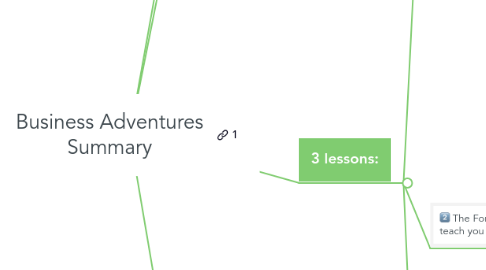
1. 1-Sentence-Summary:
1.1. Business Adventures will teach you how to run a company, invest in the stock market, change jobs, and many other things by sharing some of the most interesting experiences that big companies and their leaders have had over the last century.
2. Favorite quote from the author:
2.1. "I don't think money makes much difference, as long as you have enough." - John Brooks
3. 3 lessons:
3.1. The stock market is unpredictable and irrational, as shown by it’s three day crash and recovery in 1962.
3.1.1. Take the crash that happened in 1962 as an example.
3.1.1.1. If you had been in a coma between May 28 and May 31 of that year, you wouldn’t notice much change to your investments.
3.1.1.2. But you’d have missed out on one of the biggest events in stock market history-the 1962 Flash Crash.
3.1.1.3. Everyone was already in an abysmal mood already.
3.1.1.3.1. There had been 6 months of dropping prices across the market by the time the end of May rolled around.
3.1.1.3.2. It didn’t help that they had to update stock prices manually.
3.1.1.3.3. And on the morning of May 28, they were running late.
3.1.1.4. After realizing that the true prices of stocks were 45 minutes behind, investors began to panic.
3.1.1.4.1. They assumed that the price had fallen and they didn’t know about it, so many began quickly selling.
3.1.1.4.2. Prices began to spiral and the resulting crash decimated about $20 billion worth of stock value.
3.1.1.5. Knowing the Dow Jones couldn’t go below 500 points saved everyone though.
3.1.1.5.1. Once it got low enough, they began buying quickly.
3.1.1.5.2. They knew nearing this point meant that prices would soon rise again.
3.1.1.5.3. Within a couple of days, the entire market made a full recovery.
3.1.2. It just goes to show how unpredictable the stock market is.
3.1.2.1. You can count on investors behaving irrationally and according to their mood, which is often wrong.
3.2. The Ford Edsel is the perfect example to teach you how not to launch your product.
3.2.1. Ford Edsel was one of the ugliest cars ever.
3.2.1.1. It was also one of Ford’s biggest failures.
3.2.2. The first mistake the company made was misjudging the market.
3.2.2.1. The American car industry was going strong in 1955.
3.2.2.2. People were making more money and could afford more medium-priced cars.
3.2.2.3. Ford wasn’t doing much in this sector, so they began planning the Edsel to fix that.
3.2.2.4. But after the three years it took them to finish the car, the market had shifted 180 degrees.
3.2.2.4.1. A slowing economy and changing trends made cheaper cars more popular.
3.2.3. Another problem with the Edsel was Ford’s marketing of the automobile.
3.2.3.1. They bet big, investing $250 million into getting it ready.
3.2.3.2. And the company advertised this point.
3.2.3.3. Consumer expectations were high, but when the car finally came out it was just another vehicle like all the others out there.
3.2.4. Customers were even finding the technical aspects of the car were full of issues.
3.2.4.1. Ford had spent so much on studying the market that they failed to get the automobile in top working condition.
3.2.4.1.1. The acceleration was erratic and the breaks weren’t reliable, just to name a couple of problems.
3.2.5. If you’re building a product, don’t do it like Ford did with the Edsel.
3.2.5.1. Know the market may change, build to your customer’s needs, and make sure your product works right
3.3. You can change jobs if you have trade secrets thanks to Donald Wohlgemuth’s experience of doing so.
3.3.1. In 1962 Donald Wohlgemuth was working in the aerospace industry.
3.3.2. His employer at the time was B.F. Goodrich Company.
3.3.2.1. Wohlgemuth was the manager of the spacesuit engineering department.
3.3.3. The company had just lost a bid to its competitor, International Latex, for the famous Apollo project.
3.3.4. But it wasn’t so bad for Wohlgemuth when he got an offer from International Latex to work on the job with them.
3.3.5. After learning of his desire to take the offer, his B.F. Goodrich superiors became afraid that he’d divulge company secrets.
3.3.6. Not long later, his former employer sued Wohlgemuth.
3.3.6.1. The court had to figure out whether or not they could take action against him if he’d never broken an agreement or shown the plans to do so.
3.3.6.2. And they also wanted to determine whether someone could take a new job that may tempt them to break contractual agreements to not share trade secrets.
3.3.7. In the end, the judge decided in Wohlgemuth’s favor.
3.3.7.1. Although he could harm B.F. Goodrich with his knowledge, they couldn’t preemptively declare him guilty for anything.
